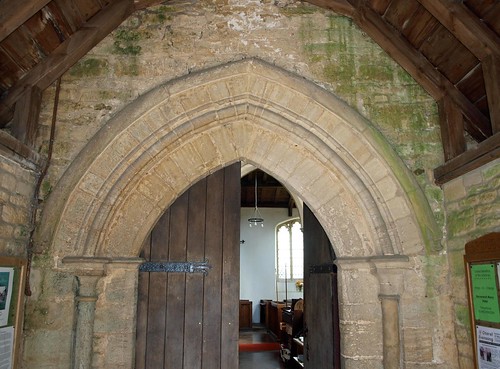ST MICHAEL. Early C13 S doorway, later C13 arcades with round piers, octagonal abaci, and double-chamfered arches, and much more interesting late C13 chancel. The chancel has windows of three stepped lancet lights (and one Dec one with reticulated tracery), a low-side lancet, a simple N doorway, and inside giant blank arches, one for each bay. On the inner walls also are stone-carved shields. They refer to the Watson family and their relations. The Watsons bought the estate c.1546. Good PISCINA. The W tower is Dec. It has pairs of transomed two-light bell-openings and a recessed spire with two tiers of lucarnes. The rest is Perp, except for one Dec S aisle window (with reticulated tracery). - COMMUNION RAIL. Early C17. Two tiers, the lower one short, stubby balusters, the upper arches with pendants. - Octagonal Wood PANEL dated 1614 with the words: SATOR ARIPO TENIT OPERA ROTAS, which is intended to read the same forwards and backwards. - PLATE. Cup and Cover Paten of 1638-9.
GREAT GIDDING. It is the biggest of the three Giddings, its cottages grouped on a little hill from where we see a battered windmill which has lost its arms. Its tower was 100 years old at the time of Agincourt; so was the chancel, but the clerestoried nave with the aisles and the porch are 15th century. The spire has been looking up most of the time.
The walls of the church have curious arcading and a remarkable company of stone faces of men, women, and angels. The roof is 400 years old, the altar-rails are massive 17th century work and are quaint, and there is an old chest with carved panels. There is an old poor-box made out of a post, and a Jacobean altar table.
A curious possession for a church is a small wooden panel in the chancel. It was carved in Shakespeare’s day, and is one of the queer puzzles people have played with for 20 centuries. This is what it says:
SATOR
AREPO
TENET
OPERA
ROTAS
Though most people regard this as a puzzle, the fact is that it is a curiosity which may have an immense significance entitling it to a place in any church. In one form or another it was known through the Middle Ages and mystical meaning was given to it; it has been thought to be a cryptogram used by the early Christians, who saw hid in it the first two words of Our Lord’s Prayer, the Latin form of Our Father, Paternoster.
The square contains all the letters in Paternoster twice except the N, with two extra A’s and O’s. By using the N as the axis point the letters can be formed into a cross spelling Paternoster both ways. The extra A’s and O’s, the first and last letters of the Greek alphabet, are the symbol of the Deity - Alpha and Omega.
It is thought that this remarkable word square, which has been found in the quarters of Roman soldiers occupied in the third century, and is also known to have been used in Pompeii, was a device of the first Christians to conceal the name of the Lord’s Prayer in their communications with one another. If this is so the fragment of the square discovered in Pompeii is the oldest piece of Christian writing in existence, and it is all the more remarkable because this square was devised and in use before the Bible itself was complete in any language.
The walls of the church have curious arcading and a remarkable company of stone faces of men, women, and angels. The roof is 400 years old, the altar-rails are massive 17th century work and are quaint, and there is an old chest with carved panels. There is an old poor-box made out of a post, and a Jacobean altar table.
A curious possession for a church is a small wooden panel in the chancel. It was carved in Shakespeare’s day, and is one of the queer puzzles people have played with for 20 centuries. This is what it says:
SATOR
AREPO
TENET
OPERA
ROTAS
Though most people regard this as a puzzle, the fact is that it is a curiosity which may have an immense significance entitling it to a place in any church. In one form or another it was known through the Middle Ages and mystical meaning was given to it; it has been thought to be a cryptogram used by the early Christians, who saw hid in it the first two words of Our Lord’s Prayer, the Latin form of Our Father, Paternoster.
The square contains all the letters in Paternoster twice except the N, with two extra A’s and O’s. By using the N as the axis point the letters can be formed into a cross spelling Paternoster both ways. The extra A’s and O’s, the first and last letters of the Greek alphabet, are the symbol of the Deity - Alpha and Omega.
It is thought that this remarkable word square, which has been found in the quarters of Roman soldiers occupied in the third century, and is also known to have been used in Pompeii, was a device of the first Christians to conceal the name of the Lord’s Prayer in their communications with one another. If this is so the fragment of the square discovered in Pompeii is the oldest piece of Christian writing in existence, and it is all the more remarkable because this square was devised and in use before the Bible itself was complete in any language.


No comments:
Post a Comment